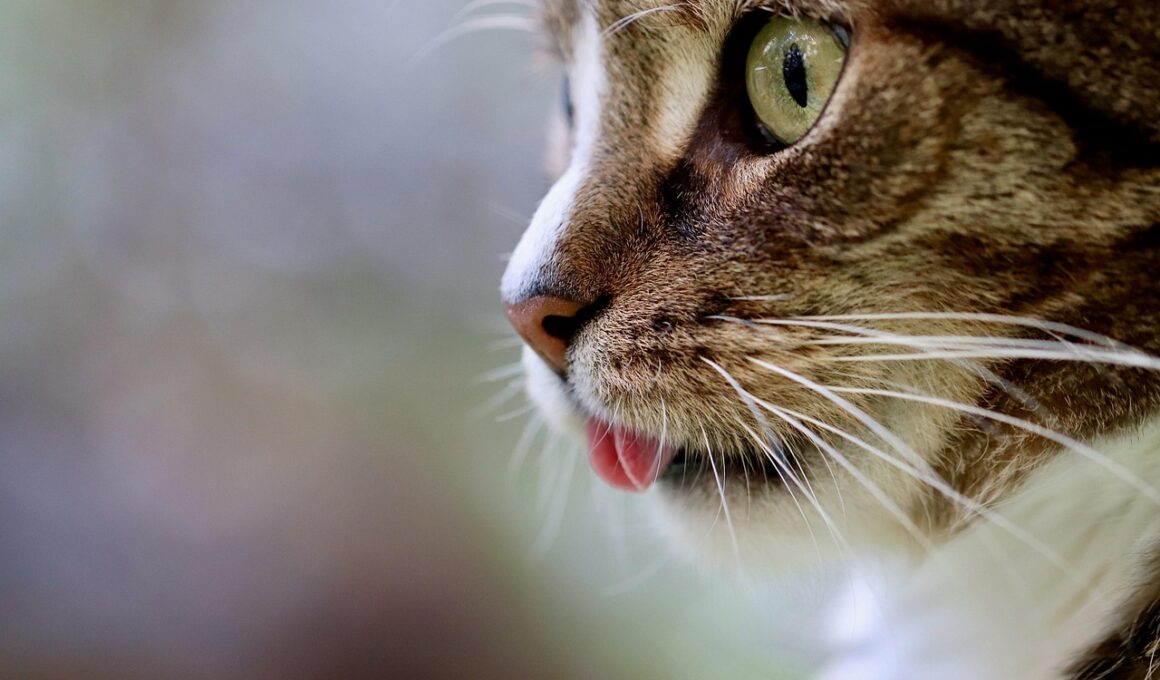Troubleshooting Common Issues When Using Audio Cues in Cat Training
Using audio cues effectively in cat training can sometimes pose challenges, especially when the desired response is not achieved. One common issue arises when cats become desensitized to the sound. To overcome this, ensure that you vary your audio cues while still remaining consistent with their meanings. You might utilize different pitches or even combine sounds that are familiar to your cat, such as using a clicker caught in a new tune. Additionally, it helps to maintain your cat’s interest by rewarding them with treats or praise immediately. If your audio cue is too soft or infrequent, your cat may not associate the sound with action in time. Increase the volume and frequency to reinforce the want for your cat to respond to the training. Lastly, if you’re having difficulty engaging your cat in learning, it could be due to external distractions. Try to eliminate noise and introduce the audio cue in a calm, quiet environment. Create a designated training zone where your cat feels comfortable to help facilitate better focus and understanding during sessions.
Another consideration when using audio cues is the environment in which training occurs. If your cat is in a space filled with distractions, they may ignore the audio cue entirely. Ensure you practice in a quiet space free from loud noises, other pets, and people. Set aside specific times for training when your cat is alert and responsive. This might be after playtime when they are calmer and more eager to learn. Observe your cat’s reactions to different audio cues; if they seem uninterested or confused, it may help to change your approach. Additionally, pairing the audio cue with a visual cue can enhance learning effectiveness. For example, while saying a command, show your cat a hand sign at the same time. This dual-method can reinforce the message you are trying to convey. Many trainers have found that cats respond better when they can see what is expected of them. Celebrate small achievements with affectionate praise or treats to boost their motivation to succeed further in their training. So remember, observations and adaptations are key components when utilizing audio cues.
Understanding Cat Behavior in Response to Audio Cues
The behavior exhibited by your cat may vary widely depending on its personality and previous experiences with audio cues. Cats can be fearful, curious, or even indifferent to sounds, which affects their training. Take note of your cat’s initial reactions to different audio cues; if they appear apprehensive or startled, it’s crucial to modify the cue in a manner that feels safer and more familiar to them. Gradually get your cat accustomed to the cue by associating it with positive experiences, such as treats, affection, or playtime. Use soothing tones and keep a consistent, calm demeanor to build trust and comfort. If your cat seems to respond positively but fails to follow through with actions, it might indicate a need for increased motivation or clarity. Experiment with varying reward systems, whether it’s a treat, a favorite toy, or verbal praise. Furthermore, some cats may need more time to comprehend audio cues than others. Patience is essential in recognizing the unique timing and learning styles of your feline companion. Adjust your strategies as needed based on your observations.
When reinforcing audio cues, the timing between the sound and the reward is vital. If there’s too long of a gap between the audio cue and the treat or praise, your cat may not associate the two. It’s essential to provide immediate positive reinforcement following the audio cue for your cat to make strong connections. This means if your cat responds correctly to the cue, reward them instantly. Sometimes, owners get too excited and forget this crucial aspect. Furthermore, ensure consistency in the rewards you give. If you frequently switch from treats to toys or other forms of reward, this may confuse your cat and deter them from pursuing the correct behavior. The goal is to create a clear understanding of the rewards associated with specific cues. Another common issue is that cats may perceive the audio cue as a command rather than a guide. Reinforcing the idea that the cue is a prompt for desired behavior instead of an order can foster a more enjoyable training experience. Cats tend to resist commands, so framing the audio cues as suggestions can illuminate their willingness to engage.
Using Varied Audio Cues Effectively
Utilizing varied audio cues can improve training efficacy, but consistency in their meaning is crucial. It’s beneficial to stick to a few distinct sounds that your cat can learn over time. Too many changes can cause confusion on the cat’s part. For instance, using a clicker for correct actions paired with a soft, distinct voice command promotes a better understanding of what is expected. When introducing new audio cues, allow plenty of time between each introduction. This could mean focusing on one sound for several training sessions before introducing another. Always start with the basics, allowing your cat to perfect their understanding of each cue before moving on to new sounds. Additionally, keeping your training sessions brief and focused can prevent your cat from losing interest. Ideally, sessions should range from five to ten minutes, but be attentive to your cat’s response. If they start to look tired or disinterested, it may be time to halt and retry later. It’s important that training remains a fun and rewarding experience for your cat, creating a positive association with learning.
Engagement during audio cue training is essential in maintaining a positive atmosphere. If your cat becomes distracted by their surroundings, it is vital to redirect their focus back to the cues. This can involve reiterating the audio cue in an encouraging tone and using treat rewards as an additional lure back to the task. Cats are more responsive to behaviors that uphold their interest, so engaging activities might be necessary. Rotate the exercises to keep your cat guessing and eagerly anticipating training. This can involve alternating between different audio cues or incorporating interactive toys during training sessions. Not only will your cat likely develop a better affinity for those cues, but they also might enjoy the process itself. If you notice your cat responding negatively to the training environment, reconsider your approach. Sometimes cats require a change of scenery for renewed focus. Choose a familiar space where your cat feels safe and comfortable, while simultaneously limiting distractions. Observing your cat’s mood and adapting your training strategy accordingly can make a substantial difference.
Concluding Thoughts on Audio Cue Training
In summary, troubleshooting in cat training using audio cues can involve numerous aspects of your interaction with your feline friend. Understanding your cat’s personality, environment, and responses will be works to your advantage. Being proactive in recognizing your cat’s behavior can immensely improve your training sessions. If one technique fails, don’t be afraid to incorporate a new method or sound. The key is patience, consistency, and the willingness to adapt to your cat’s needs. The ultimate goal of training is not just about control but to foster a closer bond between you and your cat. Celebrate successes, no matter how small, with warm affection or favorite treats, allowing them to enjoy the process as much as you do. Diversity in audio cues alongside encouraging environments enriches the experience for both you and your cat. With dedication and intelligent troubleshooting, your journey towards effective audio cue training will not only be rewarding but also solidified with newfound trust and respect.


